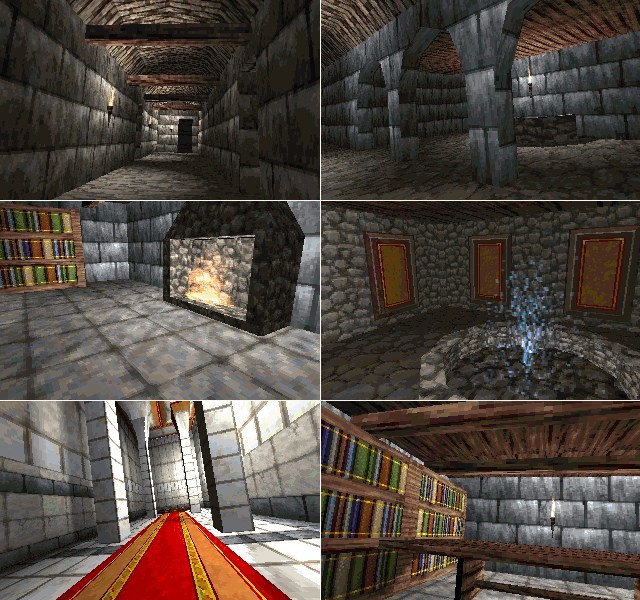 |

Submitted by , posted on 16 May 2002
|
 |

Image Description, by

The images above shows our recently released Amiga 64k intro. It is available
for download, incl. a divx video version, here:
http://loonies.dk/demos/demos.asp?id=thecastle
The target system is a MC68060/50mhz cpu, AGA (the 2nd generation Amiga graphics
chipset) and 18 mb ram. The whole thing including music takes up 64 kb on disk.
Think about the performance of recent PDAs...
The whole intro is running clean 25 fps, synchronized to the video beam, ie. a new image for
every 2nd time the video beam sweeps the screen. This gives a quite smooth performance
compared to ordinary "free running" 25 fps.
The 3D Engine
Portal like approach. Portals are placed manually and most of the time only in
the doorways, connecting the individual rooms in a graph.
Each room is then sorted by its own BSP tree. These local BSP trees ensures
minimum splitting of polygons.
Scanline based C-buffer (coverage buffer) to avoid any overdraw.
The walls etc. are rendered as convex polygons with perspective correct texturemapping.
The division involved in the perspective correct mapping is done in floating point
while mapping the next 16 pixels affine. During the remainder of the perspective mapping
calculations themselves, the memory bus is utilized copying parts the last rendered
frame to the slow graphics memory.
Dynamic objects are placed as single points in the BSP, and rendered completely at that
point in the render process (the choice of point for an object is ofcourse quite important
then). The dynamic objects includes some small particle systems, torches (as blended animated
billboards) and ordinary affine texture mapped objects.
Interrupt driven queue-like n-buffer (instead of double or triple buffer)
system to make the framerate more stable by allowing the render to render ahead
of time to save up frames for the slower parts of the scenes. This effectivily
turns our 25 fps requirement from a worst case to an average case requirement. This
is ofcourse only possible because the system is not interactive.
The 64 kb consists of the following (after compression):
30 kb code
8 kb music, including player and softsynth for samples
10 kb textures (see below)
15 kb highly compressed 3d objects
1 kb motion paths
All textures are built from the same 256 different 8x8 pixel tiles. This
makes pretty dull and repetetive textures, so noise at different frequencies
are added afterwards. Lightmaps are then calculated by interpolated
raytracing incl. manually placed shadow objects (mainly to improve
precalculation speed compared to shadows from everything). The
lightmaps and the textures are finally combined so just a single texture
has to be mapped to each polygon in the realtime part. This is ofcourse a
bit expensive memory wise, but not as bad as usual, as the textures at this point
are 8 bit only too.
The intro ended up 2nd in the amiga intro competition at Mekka-Symposium, the
most important demoscene party worldwide. However, the competition rules allowed
both 3D hardware (which also cuts away a good deal on the code size) and a PowerPC cpu
5 times faster than our 68060, and the winning intro used both.
|
|

